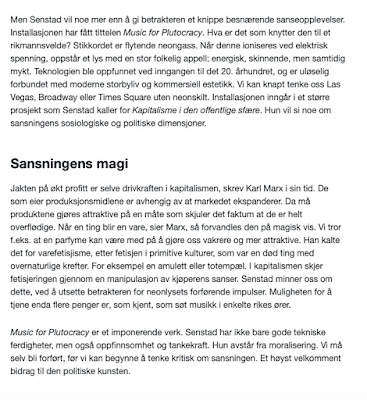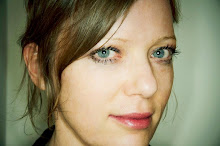Seinajöki Kunsthall
Finland
Anne Katrine Senstad
Radical Light - ELEMENTS VI
By Andres Kurg
In Radical Light – Elements VI by Norwegian
artist Anne Katrine Senstad we encounter
abstract light sculptures accompanied by
ambient sound – a space filled with particles
of white light that produce a total environment,
encompassing all the senses. Upon entering,
the viewer is welcomed by The Sensory Chamber
an intimate video installation or “antechamber”,
where the hypnotic moving images are projected
onto a bed of white salt crystals moving through
hues of blues, red, pinks, whites and turquoise.
The Sensory Chamber IV, 2021.
Photos by AKS Studio NY and Samuli Kuusisto
In the grand space, the installation Elements VI
is defined by the unity of chromatic white neon
composed of twenty-nine vertical light columns
enveloped by a white horizon that stand amidst
the concrete columns of the former industrial
and military warehouse. Slender glass tubes
filled with neon and argon, illuminate the
space at color temperatures between 3500
to 8300 Kelvin degrees, ranging from warmer
satin and egg-shell whites to colder green and
icy blue hues, indicating simultaneously the
physical character of the color white and its
cosmology of cultural narratives.
Enveloping the public in a sound environment
created specifically for Radical Light by electronic
music composer JG Thirlwell, the abstract aural
experience embodies the spatial sensations of
electrical particles, luminosity and noble gases.
In composing a sensory environment of pure light,
Senstad is primarily examining the emotional and
semiotic connotations produced by white as a
color: bright white light as eternity, purity, perfection,
a symbol of death and rebirth; or naturally clean
white as something that departs from reality
and approaches the surreal – the white tiger,
the albino moose, the great white whale.
Elements VI, 2021. Photo by AKS Studio NY
On the other hand, Senstad’s installation produces a
separation between the light source as an information
channel and its cultural meanings, demonstrating how
various shades of white are nothing more
than sensations of electromagnetic wavelengths
that can be altered by changing the ratio of noble
gases harnessed within the glass tubes.
The physical properties of neon and argon facilitate
the transportation of electricity that produce luminal
spectrums with a discrete durational hum. Light is
always physically present in space, similar to its
transformative effects on surrounding objects or
enclosing walls. The use of light as material, its
scale and the purity of the white hues, refer to a
radicalization of space and color, striving towards
their zero-degree, making it possible to pose
questions on the character of the artwork and
challenge its place within the gallery.
The idea of a pure white color has enthralled 20th
century avant-garde artists like Kazimir Malevich
or Robert Rauschenberg. It signified for them an
endpoint of previous artistic developments and a
transgression beyond the canonic rules of the
artworld. But a white canvas was simultaneously a
mirror and a blank slate, receiving signals from its
environs and registering its temporary interventions.
From that point, there was only one step towards art
that undid the separation between the artwork and
its surrounding space. Senstad’s work is situated in
the tradition of installation art, where the surrounding
environment and the viewer become part of the
work itself. By moving between the light columns,
at different speeds, on different days or at different
times, observing the change in light and shadow, the
gallery space acquires an equal role with the
installation elements and sounds.
Elements VI bears a relationship to the geographic
location in Seinäjoki – with the silvery and white hues
of the northern hemisphere during the peak of the suns’
atmospheric presence – but it also makes a reference
to the built history of its location. Not far from the
Kunsthalle stands the civic and administrative centre
of Seinäjoki by Alvar Aalto, crowned by the
monumental Lakeuden Risti Church (1957-60).
Its white interior creates emotional effects for the
viewer through the sculpturality of its vertical tectonic
elements, gently curving vaults and the seamless
transformation between the ceiling and the apse.
ELEMENTS VI, 2021 - Radical Light.
Photo by AKS Studio NY
Representing Scandinavian modernism, the
spiritual is mediated there through reduced
geometries, volumetric spatial vision and perhaps
most importantly, the light from vertical windows
reflected off from the bright white interior walls.
Unlike the church, the Kunsthalle closes itself off
from the external light and transports the viewer
to a sensorially immersive space of an artificially
controlled light and sound environment, encapsulating
the human body in a system of matrices, electricity
and glass tubes.Senstad’s invitation to contemplation
and introspection is detached from any institutional or
instrumental function. The installation becomes a
counter-environment that transforms the visitors’
perception of space and time and provides potential
for a radical cultural experience.
The exhibition is produced by Kunsthalle Seinäjoki
in partnership with Kai Art Center, Tallinn, Estonia
and The Finnish Art Promotion Centre/TAIKE.
Supported by The Royal Norwegian Embassy Helsingfors.















































